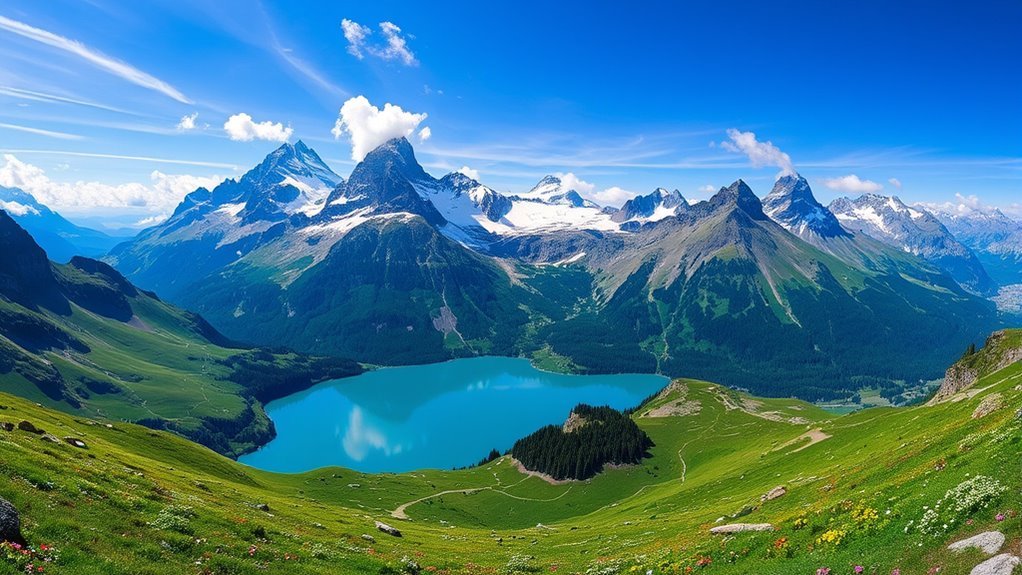When you think of the Swiss Alps, imagine a landscape that’s both majestic and diverse, where towering peaks and vast glaciers dominate. You’ll find yourself intrigued by the intricate tectonic history that shapes this iconic range. Whether you’re a thrill-seeker or a history buff, the Alps offer something for everyone year-round. But have you ever wondered how these mountains influence everything from climate to cuisine? Discover their full impact and uncover what they truly offer.
Key Takeaways
- The Swiss Alps cover 60% of Switzerland and feature 48 alpine four-thousanders, highlighting their geographical diversity.
- Climate change has caused glaciers to lose half their volume, impacting water supplies and ecosystems.
- The Swiss Alps offer a range of winter tourism activities, including skiing and snowboarding, as well as scenic routes like the Glacier Express.
- Traditional Swiss cuisine in the Alps includes fondue and raclette, with mountain cafés offering stunning views.
- The Gotthard Base Tunnel improves connectivity, making major tourist spots easily accessible from Zurich and Geneva.
Geography and Tectonic Composition
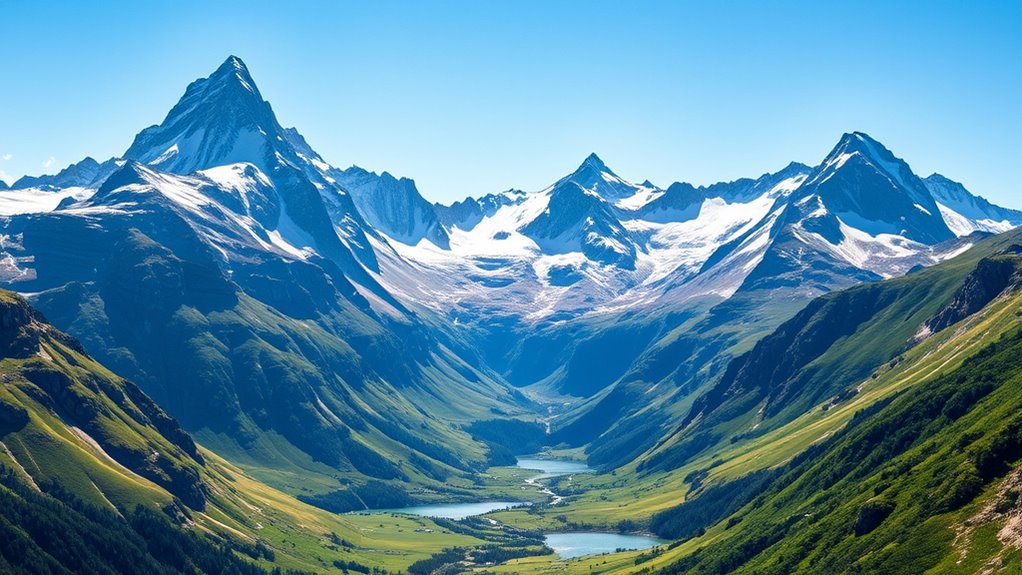
Although the Swiss Alps cover 60% of Switzerland’s total area, they account for only 14% of the entire Alps, which stretch across several countries.
When exploring the Swiss Alps, you’ll notice their remarkable geographical area, boasting 48 alpine four-thousanders. This mountain range is renowned for its complex tectonic history, shaped by Helvetic zone rocks from the European continent and Austroalpine nappes from the African continent. This tectonic composition adds to the Alps’ diverse geological character.
Glaciers in the Swiss Alps cover an area of over 1,220 square kilometers, accounting for 44% of the total glaciated area in the Alps. These glaciers are critical features, emphasizing the dynamic nature of this mountain range. Their presence is a demonstration of the powerful forces that have shaped and continue to shape this iconic landscape.
Climate and Environmental Changes
The Swiss Alps’ impressive geological features aren’t just static monuments of nature; they’re part of a dynamic environment undergoing continuous change.
You can observe how the climate, influenced by altitude, shapes diverse ecosystems. Historically, glaciers carved the landscape, creating U-shaped valleys. Now, these glaciers are shrinking, having lost about half their volume in the last century. This reduction affects water supplies, impacting hydroelectric power and agriculture.
Weather patterns bring warmer, drier summers and wetter winters, altering natural ecosystems and human activities. With heavier rainfall, flooding risks are increasing, posing a threat to infrastructure. Additionally, melting permafrost destabilizes the ground, posing further challenges.
These environmental changes demand adaptive strategies to safeguard the unique beauty and utility of the Swiss Alps.
Glaciation and Hydroelectricity
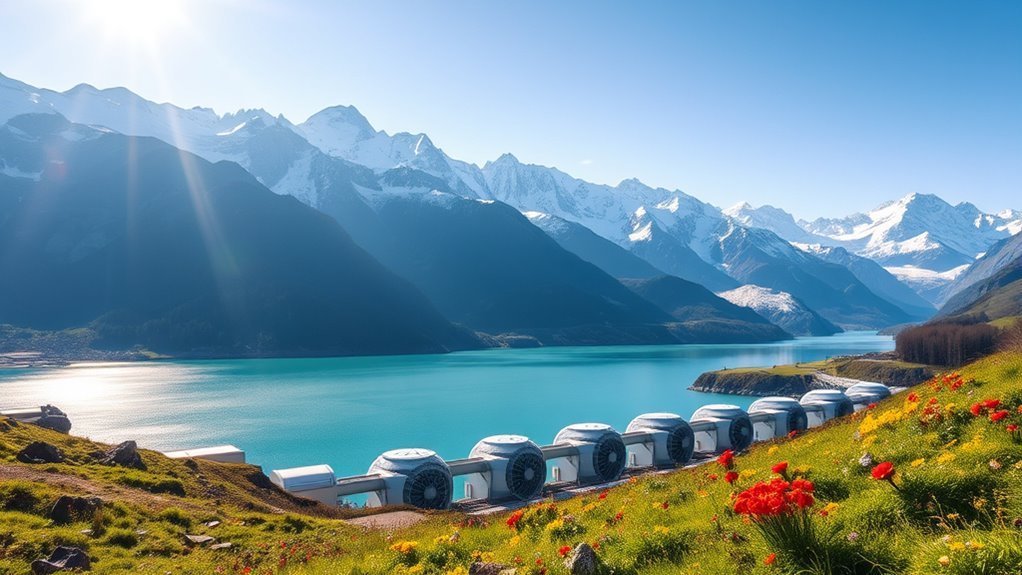
You’re about to explore how the melting glaciers in the Swiss Alps are reshaping hydroelectric energy production.
As these glaciers recede, the consistent water flow vital for generating electricity becomes unpredictable, posing significant challenges.
Switzerland’s innovative energy strategies are crucial to adapting and ensuring the sustainability of its hydroelectric infrastructure amid these changes.
Impact of Melting Glaciers
As you gaze upon the majestic Swiss Alps, it’s important to recognize the pressing challenges posed by melting glaciers. The Aletsch Glacier, a UNESCO World Heritage Site, epitomizes this glacial retreat. Melting glaciers reduce the volume of water, which in turn affects hydropower generation —a significant energy source in Switzerland. Climate change accelerates this process, leading to warmer, drier summers and increased flooding risks from destabilized permafrost.
Monitoring programs like PERMOS play a crucial role in understanding these changes and informing energy strategies. Glacial meltwater, essential for hydroelectricity, is dwindling, which impacts the consistency of the supply. As the glaciers recede, energy strategies must evolve to address these shifts.
Here’s a glance at the situation:
| Aspect | Details |
|---|---|
| Glacial Retreat | Aletsch Glacier is shrinking |
| Energy Impact | Reduced hydropower generation |
| Climate Influence | Warmer, drier summers |
| Flooding Risks | Increased with heavy rainfall |
| Monitoring Efforts | PERMOS tracks changes |
Hydroelectric Energy Challenges
Recognizing the impact of melting glaciers, let’s now consider the pressing hydroelectric energy challenges tied to glaciation.
In the Swiss Alps, hydroelectric energy production heavily depends on glaciers for consistent water flow. The Aletsch Glacier, being the largest, highlights the importance of glacial meltwater for rivers that are crucial to power generation.
However, with climate change, glaciers are losing mass, disrupting water availability. Warmer, drier summers and wetter winters further complicate this by making the water supply unpredictable.
Additionally, melting permafrost and increased flooding risk can cause damage to hydroelectric systems.
Switzerland, a leader in renewable energy, must innovate and adapt to these challenges to sustain its energy production, ensuring that hydroelectricity remains a reliable resource despite the ongoing environmental changes.
Travel and Tourism Activities
Although the Swiss Alps are synonymous with winter sports, their allure extends far beyond just skiing and snowboarding.
Winter tourism here thrives with iconic scenic train rides, such as the Glacier Express, which offers breathtaking views of the Alps. You can immerse yourself in a variety of outdoor activities, from exploring the vast Aletsch Glacier to hiking historic trails such as the Gemmi Pass.
The Swiss Travel Pass makes it easy to navigate the region’s top tourist destinations, allowing seamless travel across Switzerland’s public transport network.
Effortlessly explore Switzerland’s top sights with the Swiss Travel Pass, ensuring seamless public transport journeys.
Don’t miss the opportunity to explore the Swiss Alps in summer, where hiking and biking in places like Verbier provide thrilling adventures.
The Alps promise unforgettable experiences, no matter the season.
Dining and Culinary Experiences
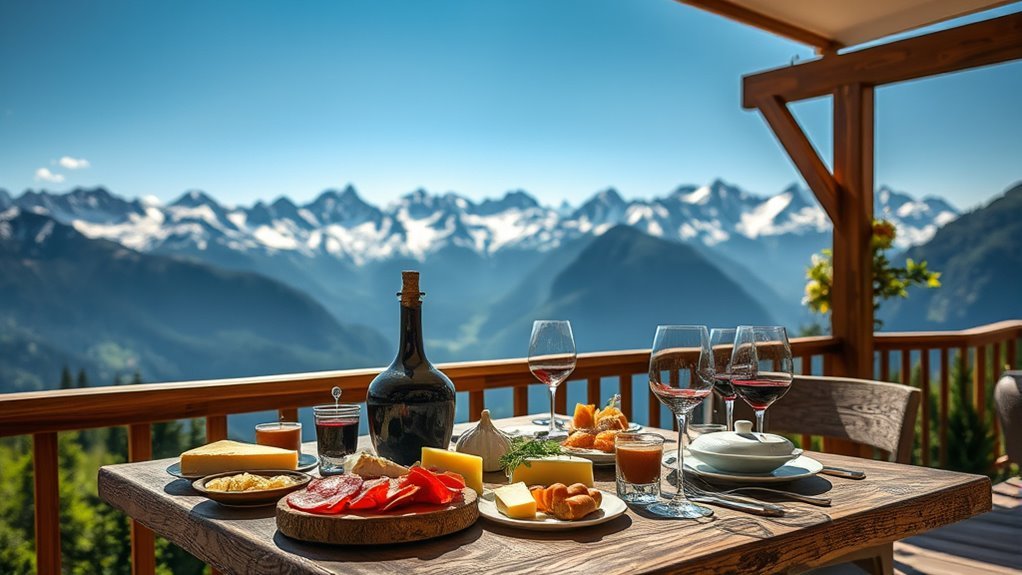
When you explore the Swiss Alps, you’re in for a culinary treat with options ranging from traditional Swiss dishes like fondue to gourmet experiences at Michelin-starred restaurants.
Imagine savoring a meal with locally sourced ingredients at a cozy mountain café, all while surrounded by breathtaking views.
Whether you’re enjoying seasonal specialties in a charming eatery or indulging in high-end cuisine, the Alps offer dining experiences as diverse as their landscapes.
Traditional Swiss Cuisine
While exploring the Swiss Alps, you’ll discover that traditional Swiss cuisine is a delightful fusion of the country’s diverse regions.
Renowned for its hearty dishes, Swiss cuisine prominently features cheese, a local ingredient with over 450 varieties produced throughout the country. Immerse yourself in a pot of fondue, where melted cheese pairs perfectly with crusty bread, or try raclette, another delicious cheese option.
Rösti, a crispy potato dish from Bern, also highlights the Swiss love for simple, satisfying meals. The emphasis on local ingredients extends to meats and seasonal vegetables, ensuring every dish is fresh and flavorful.
As you savor these traditional dishes, you’ll also discover gourmet interpretations in cozy mountain huts, bringing innovative twists to beloved classics that captivate both locals and tourists alike.
Gourmet Dining Options
As you explore the Swiss Alps, you’ll find a mesmerizing array of gourmet dining options that reflect the region’s rich culinary heritage.
The Swiss Alps cover a tapestry of flavors with restaurants like Chäs-Beizli, where you’ll enjoy exemplary Swiss cuisine using local flavors and ingredients.
At Restaurant Ecco Ascona, savor an international menu that highlights vegetarian-friendly dishes crafted from seasonal produce.
For a delightful fusion, Mare e Monti offers a blend of Italian and Mediterranean dishes, showcasing regional culinary influences.
La Sitterie offers an exquisite dining experience featuring French and Swiss dishes, accompanied by stunning alpine views.
Don’t miss Ristorante Locanda Orico Da Albrici, where authentic recipes and fresh ingredients elevate Italian and seafood dishes to new heights.
Mountain Café Experiences
Nestled among the breathtaking landscapes of the Swiss Alps, mountain cafés offer a unique dining experience that combines culinary delights with stunning panoramic views.
Imagine savoring traditional Swiss cuisine, such as fondue and raclette, in cozy settings after a day of scenic hikes or skiing. These cafés, strategically positioned near popular destinations, provide the perfect respite with their local delicacies and traditional dishes made from locally sourced ingredients.
As you relax, enjoy views of iconic peaks, such as the Matterhorn. Seasonal specialties, including fresh alpine herbs and berries, showcase the region’s rich biodiversity.
Accessible via cable cars or invigorating hikes, mountain cafés are must-visit spots for both tourists and locals exploring the Alpine regions, promising a memorable dining adventure.
Transport and Accessibility
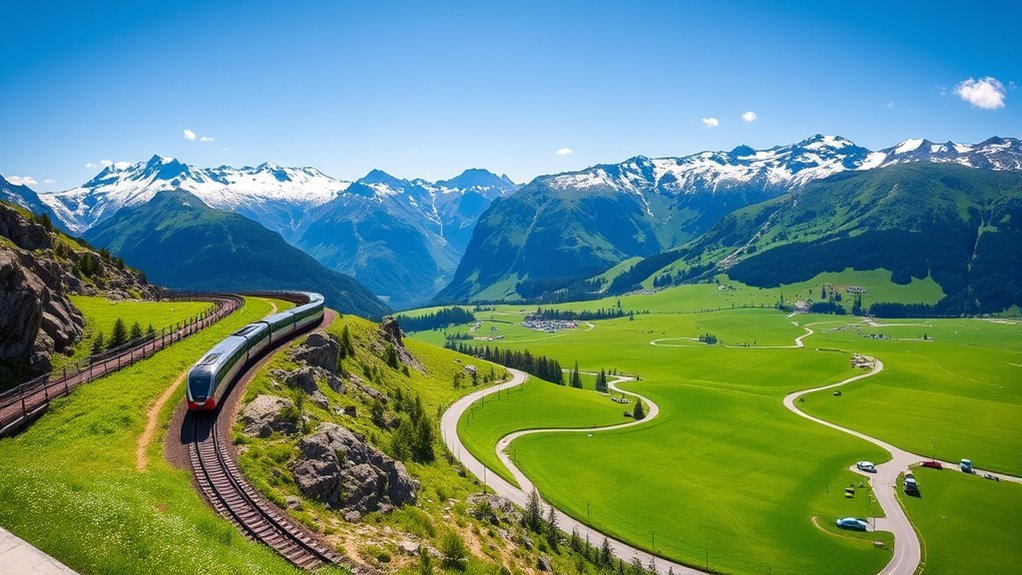
Exploring the Swiss Alps is remarkably easy, thanks to a thorough public transport network that connects you seamlessly to its stunning landscapes.
With Swiss Federal Railways and Rhaetian Railway, you can enjoy scenic train routes like the Glacier Express, offering a 7.5-hour panoramic journey through the Alps.
Regional passes, such as the Bernese Oberland Regional Pass, make travel effortless, letting you hop on and off as you explore.
Zermatt, a car-free haven, encourages public transport use, ensuring a peaceful visit.
The Gotthard Base Tunnel, the world’s longest railway tunnel, enhances accessibility by efficiently bridging northern and southern Europe.
Within 1 to 3 hours, you can reach major tourist spots from cities like Zurich and Geneva, taking in the beauty of the Alps.
Seasonal Recommendations and Travel Tips
When planning a trip to the Swiss Alps, focus on the season to make the most of your experience.
Consider the season when planning a trip to the Swiss Alps for an optimal experience.
For high-altitude alpinism, July and August offer the safest conditions for climbing peaks over 4,000 meters. If you prefer hiking tours, explore the scenic trails in the Jura range and the lower cantons of Vaud, Fribourg, and Valais during off-peak seasons.
Winter sports enthusiasts should be aware that skiing seasons are getting shorter, so plan accordingly.
Zermatt, a car-free haven, relies on public transportation, making it easy to access the top hiking and skiing spots. For convenience, book your accommodation near these activities, especially during peak tourist seasons, to ensure a seamless and enjoyable visit.
Conclusion
When you visit the Swiss Alps, you’ll discover a stunning blend of natural beauty and adventure. Explore the diverse landscapes shaped by tectonic forces and shifting climates, and witness the impressive glaciers that generate hydroelectric power. Enjoy exhilarating activities year-round, from skiing to hiking, while savoring unique culinary delights. With easy accessibility and rich history, the Swiss Alps promise an unforgettable experience. Pack your bags and get ready for a truly one-of-a-kind adventure!
FAQs
1. What Is so Special About the Swiss Alps?
You’ve got majestic landscapes, thrilling sports, and rich history all in one place. Imagine skiing down iconic slopes or hiking glaciers, knowing you’re in a region that revolutionized tourism. The ease of access adds to the appeal.
2. Where are the Swiss Alps Located?
You’re curious about the location? You’ll find them in southern Switzerland, stretching from Vevey on Lake Geneva to Rorschach on Lake Constance. They separate the Swiss Plateau in the north from the south of the mountains.
3. Which City Is Closest to the Swiss Alps?
You’re wondering which city is closest. Zurich, about 30 kilometers away, provides the most convenient access. It’s a perfect gateway for your alpine adventures, offering quick routes to explore the stunning mountain landscapes and nearby attractions.
4. Are the Swiss Alps Expensive?
You’ll find it’s costly with hotel rates often high, dining expenses steep, and ski passes pricey. Transportation fees and activity costs add up quickly. Planning carefully can help manage expenses while enjoying your trip.
